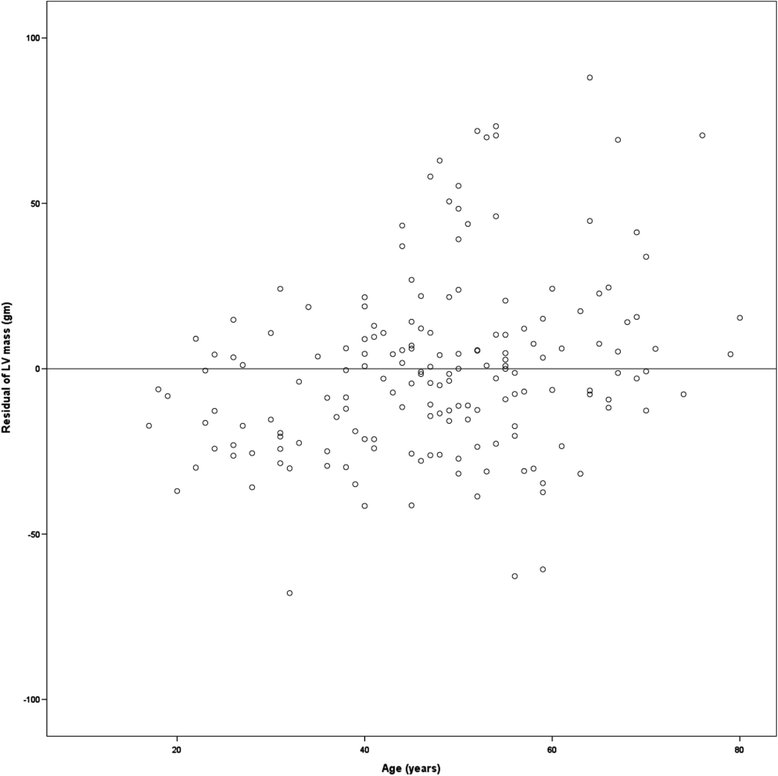Revised definition of predicted left ventricular mass using ambulatory blood pressure in healthy Korean adults
- PMID: 28417009
- PMCID: PMC5392383
- DOI: 10.1186/s40885-017-0064-2
Revised definition of predicted left ventricular mass using ambulatory blood pressure in healthy Korean adults
Abstract
Background: Left ventricular hypertrophy is influenced by both hemodynamic and non-hemodynamic factors. Ambulatory blood pressure is correlated with left ventricular hypertrophy. We established the influences of hemodynamic and non-hemodynamic factors, including ambulatory blood pressure, on variation in left ventricular mass in healthy Korean adults.
Method: We included 172 subjects (male = 71, female = 101), with normal body mass index and blood pressure, in an analysis of data from the Yangpyung and Yeoju cohort studies and a tertiary cardiovascular center. Left ventricular mass was calculated using the equation: [1.04 × (IVSd + LVDd + PWTd) 3-(LDVs3)] × 0.8 + 0.6. Stroke volume was calculated (mL/beat) using Teichholz's formula. Stroke work (SW in gram-meters/beat [g-m/beat]) was computed as ambulatory systolic BP × stroke volume × 0.0144.
Results: Stroke work was the most important determinant associated with left ventricular mass (adjusted R2 = 0.442, p < 0.001), independent of height2.7 and sex. In a regression model including stroke work, height,2.7 and sex, the left ventricular mass was predicted by the equation: 43.11 + 0.61 × SW (g-m/beat) + 9.21 × height2.7-13.99 × sex (male = 1, female = 2) (constant = 43.11 ± 25.88, adjusted R2 = 0.532, p < 0.001).
Conclusion: We examined ambulatory blood pressure, as in previous studies, and identified stroke work, height2.7, and sex as important determinants of left ventricular mass in Korean adults of normal weight and normal blood pressure. Ambulatory blood pressure is superior to clinical blood pressure for determining stroke work and predicted left ventricular mass.
Keywords: Ambulatory blood pressure monitoring; Left ventricular hypertrophy; Stroke work.
Figures
Similar articles
-
Ambulatory blood pressure and left ventricular mass index in hypertensive children.Hypertension. 2002 Apr;39(4):903-8. doi: 10.1161/01.hyp.0000013266.40320.3b. Hypertension. 2002. PMID: 11967247
-
Ambulatory 24-hour blood pressure monitoring: correlation between blood pressure variability and left ventricular hypertrophy in untreated hypertensive patients.G Ital Cardiol. 1998 Jan;28(1):38-44. G Ital Cardiol. 1998. PMID: 9493044
-
Relation of left ventricular hemodynamic load and contractile performance to left ventricular mass in hypertension.Circulation. 1990 Jan;81(1):25-36. doi: 10.1161/01.cir.81.1.25. Circulation. 1990. PMID: 2297829
-
Blood Pressure Monitoring. Task force III: Target-organ damage, morbidity and mortality.Blood Press Monit. 1999 Dec;4(6):303-17. doi: 10.1097/00126097-199912000-00004. Blood Press Monit. 1999. PMID: 10602535 Review.
-
Left ventricular hypertrophy: how to influence an important risk factor in hypertension.J Hypertens Suppl. 1998 Jan;16(1):S53-8. J Hypertens Suppl. 1998. PMID: 9534098 Review.
Cited by
-
Injectable hydrogels for the sustained delivery of a HER2-targeted antibody for preventing local relapse of HER2+ breast cancer after breast-conserving surgery.Theranostics. 2019 Aug 14;9(21):6080-6098. doi: 10.7150/thno.36514. eCollection 2019. Theranostics. 2019. PMID: 31534538 Free PMC article.
References
LinkOut - more resources
Full Text Sources
Other Literature Sources

